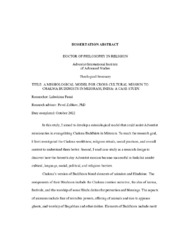| dc.description.abstract | In this study, I aimed to develop a missiological model that could assist Adventist
missionaries in evangelizing Chakma Buddhists in Mizoram. To reach the research goal,
I first investigated the Chakma worldview, religious rituals, social practices, and overall
context to understand them better. Second, I used case study as a research design to
discover how the Seventh-day Adventist mission became successful in Sedailui amidst
cultural, language, social, political, and religious barriers.
Chakma’s version of Buddhism blend elements of animism and Hinduism. The
components of their Hinduism include the Chakma creation narrative, the idea of karma,
festivals, and the worship of some Hindu deities for protection and blessings. The aspects
of animism include fear of invisible powers, offering of animals and rice to appease
ghosts, and worship of Bogabhan and other deities. Elements of Buddhism include merit
making, the 3 jewels (the Buddha, dhamma, and sangha), the 4 noble truths, the middle
path, removal of the 10 fetters, and admiration of Buddha. The other aspects of Buddhism
include salvation by works, the law of karma, the cycle of death and rebirth, the cessation
of reincarnation, and the panchosil (5 precepts). The mixture of these religious elements
greatly influences Chakmas and leads them to religious syncretism.
Relationship building through a group-oriented approach, sharing Bible stories in
ways through which Chakmas could relate the teachings to their beliefs and practices, and
winning their confidence played a crucial role in the success of the Adventist mission in
Sedailui. These components of the successful Adventist mission in Sedailui, along with
the challenges faced by Adventist missionaries, contributed to the creation of a
contextualized missiological model for presenting the Gospel in the Chakma’s frame of
reference. At the same time, existing contextual communication methods were integrated
into this model.
A contextualized missiological model proposed in this study consists of 7 main
points. The first point is pre- and on-field trainings to prepare Adventist missionaries for
fieldwork. The second point is the top-down model, Christ’s integrative evangelistic
approach, and multi-individual, mutually interdependent conversion methods to establish
relationships with Chakmas and pave the way for evangelism. The third is integrating
contextualized communication models. The fourth is presenting Christ in a way Chakmas
can relate Him to their everyday life and worldview. The fifth is providing functional
substitutes and making changes in the 3 dimensions of culture to assist worldview
transformation. The sixth is assisting Chakmas in decision making for conversion.
Finally, the seventh point is discipling Chakma converts to grow spiritually. These 7
components worked together to create a missiological model which Adventist
missionaries can use to convey the Gospel to Chakmas in terms that are understandable to
them and can transform their worldview. | en_US |

